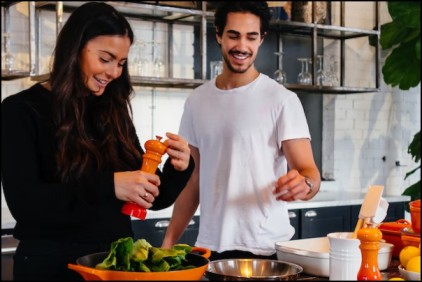Table of Contents
Describe a Time When You Taught a Friend/Relative Something

Cue Card
You should say:
- Who you taught
- What/how you taught
- What the result was
- And explain how you felt about the experience
Sample Answer
Recently, I had the privilege of instructing my wife on the art of cooking eggs and tomatoes. Being a culinary enthusiast myself, I was thrilled to pass on my knowledge and skills to my better half. She had expressed an interest in expanding her cooking repertoire, so I jumped at the opportunity to guide her in this endeavor.
To start off, I walked her through the basics of cracking eggs and whisking them in a bowl to create a smooth and creamy texture. Then, I demonstrated how to dice ripe, juicy tomatoes and incorporate them into the egg mixture for added flavor and color. I also showed her various techniques for cooking the eggs to perfection, such as how to control the heat and gently fold the eggs to prevent them from becoming tough and rubbery.
Throughout the process, I peppered her with tips and tricks of the trade, using phrases and idioms that are common amongst seasoned cooks. I could see the eagerness in her eyes as she absorbed every piece of information I imparted, and I couldn’t help but feel a sense of pride and accomplishment.
Finally, the moment of truth arrived as we sat down to enjoy our breakfast together. I was overjoyed to see the delight on my wife’s face as she took her first bite, and I could tell by the satistied look on her face that she was pleased with the outcome. She even went on to complement the dish, remarking or
its delightful texture and mouth-watering taste.
In conclusion, teaching my wife how to cook eggs and tomatoes was a gratifying experience that further solidified our bond. Not only did she learn a new skill, but she also acquired a newfound appreciation for the culinary arts. I felt fulfilled knowing that I was able to impart my knowledge and contribute to her personal growth.
Part 3
1. What practical skills can young people teach old people?
Young people have a wealth of knowledge and practical skills that they can share with the older generation.
Some of the skills that come to mind include digital literacy, social media savvy, and proficiency in using various gadgets and technology.
In addition, young people can also teach older individuals more practical life skills such as budgeting, meal planning and preparation, and home maintenance.
The key to effectively teaching these skills to older individuals is to approach the task with patience and understanding.
2. What skills can young people teach old people besides technology?
Aside from technology, young people can also teach old people various other skills that can help improve their quality of life.
For example, they can teach them how to be more physically active by demonstrating simple exercises or yoga poses. They can also help older people develop a green thumb by teaching them how to grow a vegetable garden.
Furthermore, young people can share their knowledge of alternative medicine, healthy eating habits, and stress management techniques with older individuals.
3. How can young people teach old people skills?
Young people can teach older individuals skills in a variety of ways, including hands-on demonstrations, one-on-one lessons, and group classes.
It’s essential to choose the most suitable method based on the older person’s learning style and individual needs. For example, hands-on demonstrations work best for kinesthetic learners, while one-on-one lessons are more effective for auditory learners.
Group classes are great for older individuals who enjoy socializing and learning in a group setting.
4. How can we know what to do when we want to learn something new?
When it comes to learning something new, it’s essential to do your research and seek out resources that can help you reach your goals.
This can include online courses, books, and workshops, as well as talking to experts in the field or seeking out mentors.
Additionally, it’s important to be proactive and take the initiative to learn, rather than waiting for opportunities to come to you.
With the right mindset and determination, anyone can master a new skill or acquire new knowledge.
5. Do you think ‘showing is a better way than telling in education?
The answer to this question depends on the individual’s learning style and the type of information being taught.
In general, showing is often a more effective method of teaching than telling, as it allows the learner to see and experience the information in a tangible way.
This type of learning is particularly useful for kinesthetic learners who benefit from hands-on demonstrations and physical experiences.
However, for some learners, verbal instructions and explanations may be more effective, especially for auditory learners.
Ultimately, the best method of teaching is one that is tailored to the individual’s learning style and needs.
6. Do people in your country like to watch videos to learn something?
It’s safe to say that people in my country, like in many others, have a great appreciation for visual media, including videos.
Many individuals prefer to watch videos to learn something new, as they find them to be more engaging and entertaining compared to reading a text-based resource.
Additionally, videos allow learners to see the information being presented in a visual format, which can help to increase their understanding and retention of the material.
With the proliferation of online video platforms and the increasing availability of instructional videos, it’s not surprising that many people are turning to videos as a way to learn new skills and acquire knowledge.
Some IELTS Speaking part 2 cue-cards you may like :
- (2024) Describe Another City You Would Like To Stay For a Short Time
- (2024) Describe Your Favorite Place in Your House Where You Can Relax
- (2024) Describe a Piece of Technology You Own That You Feel is Difficult to Use
- (2024) Describe An Unusual Meal You Had – IELTS Speaking Part 2
- (2024) Describe An Activity You Enjoyed In Your Free Time When You Were Young
- (2024) Describe a Person You Met At a Party Who You Enjoyed Talking With
- (2024) Describe a Piece of Good News That you Heard About Someone You Know Well
- (2024) Describe a New Development in The Area Where You Live (e.g. Shopping Mall, Park…)
Credits
Image : Photo by Jason Briscoe on Unsplash


